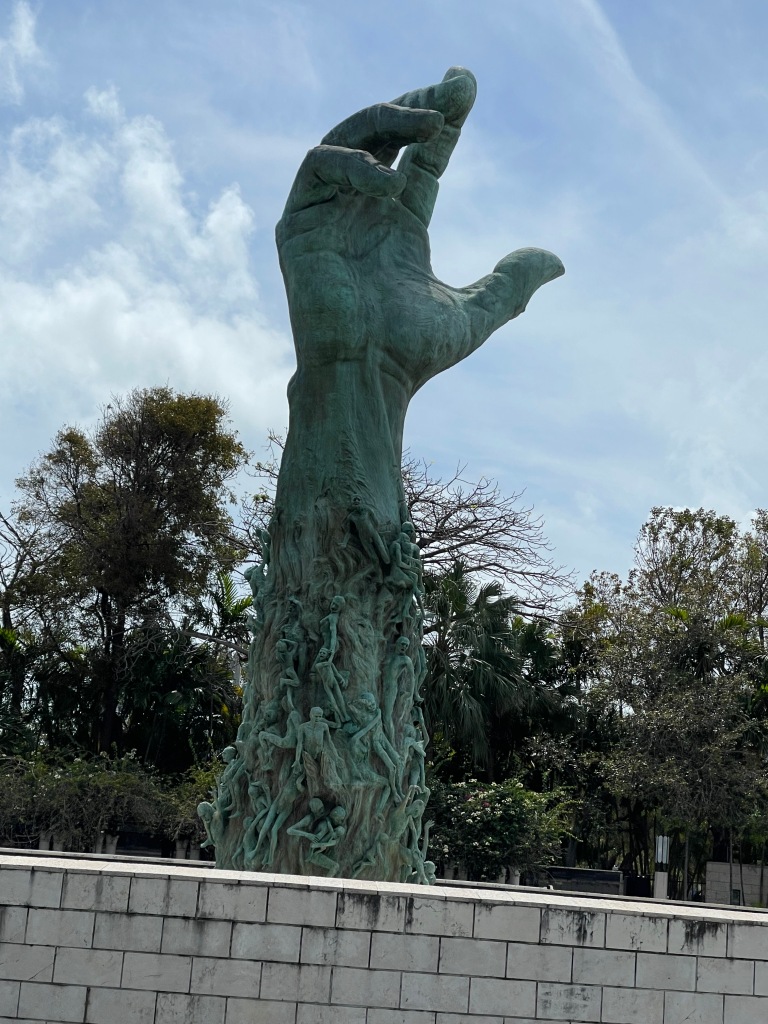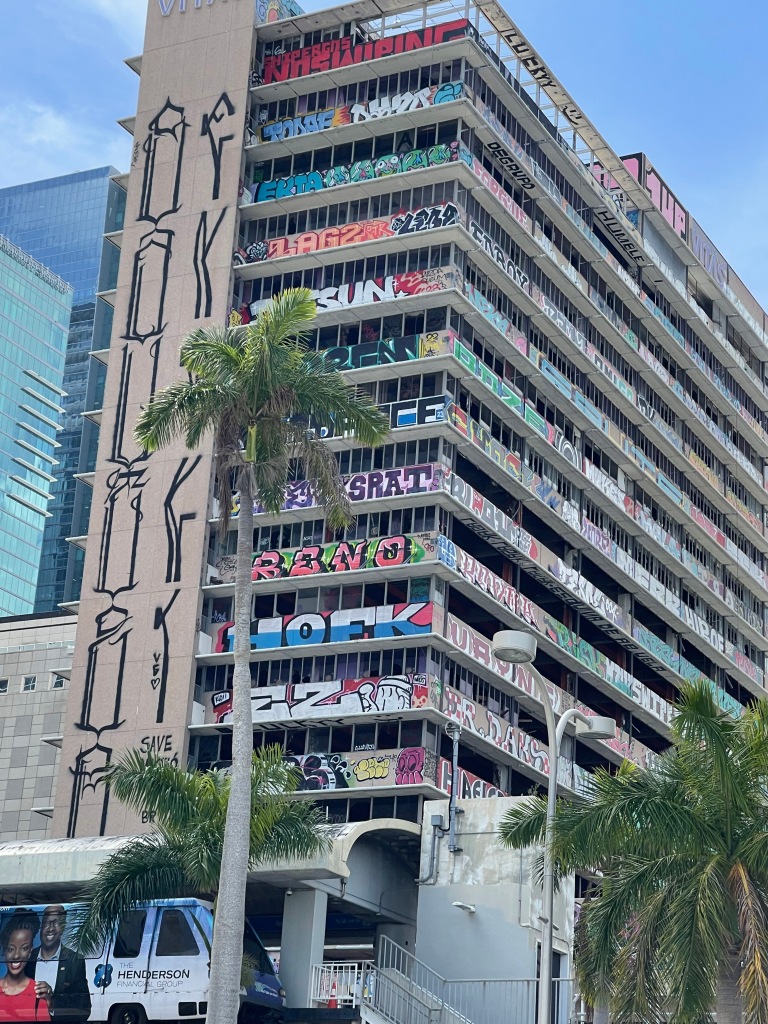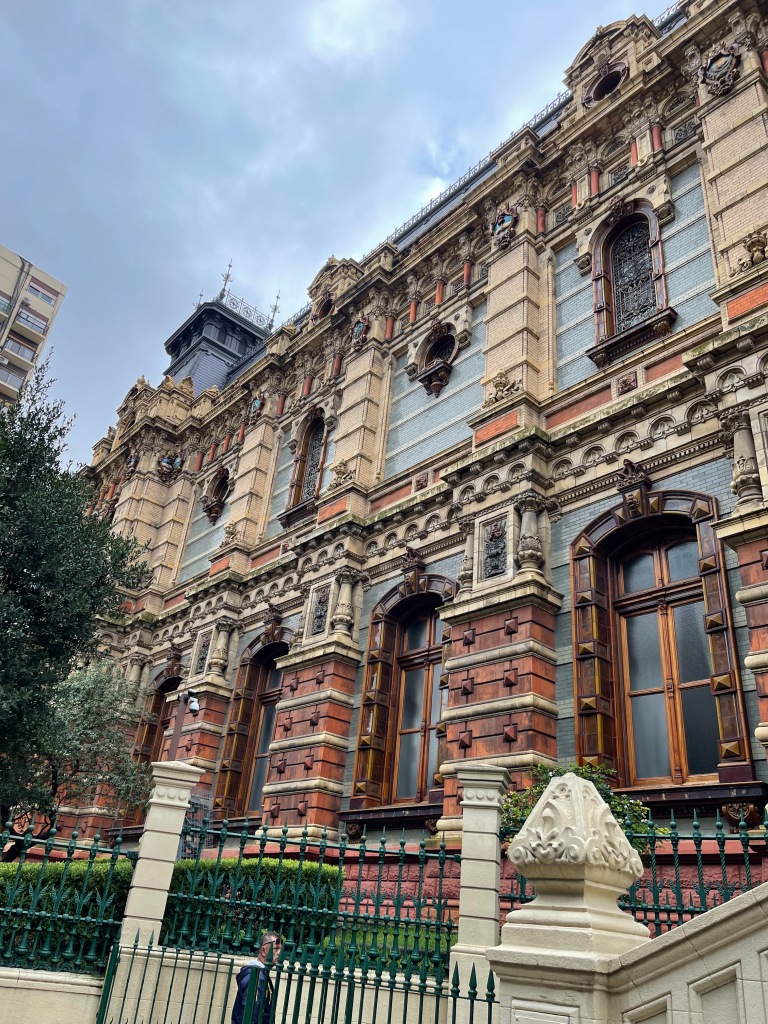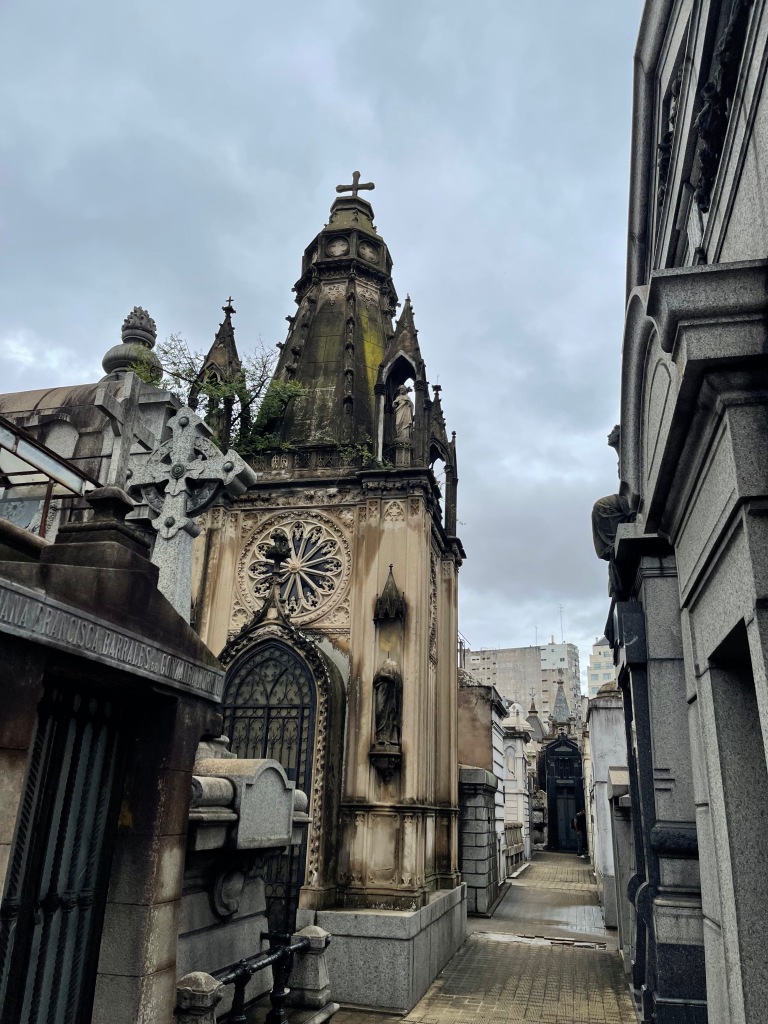I prepared for a recent trip to South America by reading short stories by Jorge Luis Borges. I think a combination of those surreal stories and a recommended typhoid shot gave me crazy dreams before departure.
To make a long dream short … I had finally got on the roof of the house where I grew up. It was covered with moss and tumbleweeds. And it was windswept. I could see Gloucester City Hall and a quaint but industrial-looking Danversport. I considered descending a dangerous outside ladder and creaky indoor stairs. The only person who could walk carefree on the roof was Billy Jack. …
“From the sun and fun capital of the world …”
The trip to South America began in Miami, USA.
From the plane, the sweep of the eastern seaboard immediately pulled me in. Some freighters. Going where? Even saw the western edge of the Bahamas (as I had claimed to make out the distinct port of Hamburg during an earlier trip). The bright-sky offered another reminder of my floaters.
Miami Beach has great beachfront and the kind of public access that all states should require. The art deco history is interesting. Much of the food and drink is fancy and good. The vegetation is lush and succulent. The ritzy neighborhoods remind me of Scarface. But the main cultural memory is Jackie Gleason. It being Florida, beachgoers are treated to a banner ad with the pitch: “Shoot Machine Guns @ Lock and Load Miami.” (Thanks Gov. DeSantis.)
We had gourmet hotel fare at upscale Byblos and at the bar of world hero Jose Andreas, whose MB restaurant is at the Ritz (though I’m always embarrassed to be at a Ritz). Jose served good apps but the pressed caviar was hard to figure. Served on beeswax?
Stepping back down to earth, we found good Peruvian and Colombian restaurants. A Cuban dinner in MB was better than the Little Havana meal I remember a year earlier. Our favorite happy hour spot on Española Way was playing the Clash and T-Rex. And a dive called Cucu’s Nest attracted a mix of hillbillies and underage drinkers downing shots.
Miami Beach Botanical Garden never disappoints. Lizards and all manner of tropical flora such as vining orchids and Florida Pines. The powerful Holocaust Museum sits astride. Fried fish in Stiltsville. And myriad canals with true small boat life.
At North Beach, the abandoned storefront of Goldstein’s Prime Kosher Market reminds me of the Jewish heritage of the area. A few miles away in Miami’s Bayside, a single Palestinian protester asks if we are American, then scolds us for the current genocide in Gaza.
A water taxi from MB to downtown Miami is very informal and unreliable (we waited for one that was more than an hour late) but offers a good chance to see interesting infrastructure in the biggest cruise ship port in the world. (Can’t hold a candle to similar cruise around port of Rotterdam, but still cool.)
Downtown Miami has mostly not come back. The Metro Mover monorail is free and efficient but its tangle of tracks at tree level mars the city landscape. The Brickell biz district is sickeningly corporate.
The Perez art museum is interesting with shows on Gary Simmons and Yayoi Kusama. Rubell Art Museum in Allapattah is also impressive. The wall space in both contemporary art museums is enormous. And the cafes in both museums offer a refuge in otherwise dismal neighborhoods. I’m especially impressed by the healthcare students celebrating promotions over a meal at the Rubell museum cafe.
The flight of the Condor …
After Miami, we continue on to Uruguay and Argentina. We start with a layover in gigantic São Paulo, whose sprawl from the air seems endless. We don’t leave the airport, trying to avoid exposure to yellow fever. We meet Steve and continue on to Uruguay. A handful of freighters seem close enough in line to talk with each other.
First day in Montevideo, we have lunch at a market that reminds me of the larger central market in Santiago. I’ve told myself I can’t avoid the grilled meat that makes Uruguay famous. But conscious of a meaty future, I chose baby squid grilled on the parrilla. Steve gets suckling pig, a favorite memory from Spain. We share beer in liters and continue on the street after lunch. A danger and pleasure of getting together with Steve.
Joanne’s cousins had asked before the trip, why Montevideo? When Billy and Nastya toyed with honeymooning there, I entertained the same question. Turns out it’s a fascinating city with ocean and river confluence. We stayed in Ciudad Vieja across from the Mercado de Artisanes. Beyond the old city, shop-filled streets of the Centro neighborhood are lined with sycamores. No department stores, but small specialized shops that cluster in neighborhoods: one bookstores, one fabric shops, one furniture … and so on.
Inevitable mixed grill on parilla featured sweetbread and kidneys for me. Death on a plate. And delicious in memory. But ofally disgusting. (Later, I was a bit nauseated to read that a New Haven shop was offering a smoothie that includes organ meat.)
Uruguay and Argentina, along with Chile, made up key Operation Condor countries whose dictators worked with each other and the U.S. Army’s School of the Americas to “disappear” and murder critics in the 1970s and 80s. Markers of that grim past—from understated street memorials noting victims of “el terrorismo de estado” to dedicated memory museums—comprise significant sightseeing in these places.
The Museo de la Memoria in Montevideo is smaller than the Museo de la Memoria y los Derechos Humanos we had visited in Santiago. Clearly, it hits a raw nerve with our tour guide. As it did with out hotel host Juan, who turned out to be a parking garage attendant and curator in his other jobs. He and the guide tell of families being exiled to Argentina, Columbia, Costa Rica, anyplace the Condor had not yet swooped. One museum exhibition shows the pots and pans Uruguayans clanked to protest the dictatorship (calling to mind their use to celebrate the heroics of healthcare workers during Covid). Abundant graffiti honoring the “disappeared” and praising labor actions seems to suggest that protest and activism are alive and well. But there’s also a sense it could be fleeting.
The Paris of South America?
I had hoped the Buquebus ferry up the Rio de la Plata from Montevideo to Buenos Aires would be a highlight of the trip. Unfortunately, you couldn’t go outside, and the windows were fogged. Where I could see out, the river was wide and the shores too far away to make out much, until the towers of Buenos Aires loomed ahead.
Buenos Aires is almost Madrid, but not. The city and country are in a sort of state of economic civil war. The recently elected president has downplayed the crimes of the country’s dictatorship and called for economic shock therapy. ATMs and corner stores don’t want to dispense cash. Service staff are elated by tips in US dollars.
Our airbnb in San Telmo is beautiful, spacious and artsy feeling.
The San Telmo flea market is fascinating. Mate cups and straws, antiques, old LPs, crafts, lots of kitschy images of Messi and Maradona.
In Buenos Aires, good fish is hard to find. But we find a marisco soup between the grand Avenida 9 de Julio (the model perhaps for the schoolbooks I remember calling BA “the Paris of South America”) and the Congress building, where I imagine some sort of Jan. 6 kind of disruption in the future.
Running water
One of our main sightseeing targets in Buenos Aires was the Palace of Aguas Corrientes—the toilet museum to you and me. On our first attempted visit, it was closed thanks to an employee strike against the government. On our second attempt, the palace was open. It is a true paradise for a man obsessed with infrastructure and good toilets
Not sure why South America turns my mind to plumbing? During a trip to Chile a few years ago, I prioritized seeing the water swirl a new way down drains, thanks to the Coriolis effect. Not so far South, but in Isla Mujeres, I obsessed about what could and couldn’t be flushed down fragile toilet systems.
The Palace of Aguas Corrientes (Running Water), built in the late 19th century, features French-style mansard rooves beautiful tiles and three floors of giant iron water tanks holding water pumped from nearby rivers then distributed to the city. The museum on the site features a collection of tiles, faucets, old toilets, bidets and pipes.
At the Buenos Aires Catedral, I realized Catholicism has taken up a disproportionate share of my sightseeing over the years. A bit more important here, where the native son pope spars with Messi as the world’s most famous Argentines.
At a nice lunch, our lefty friends diss bourgeois neighborhoods … but, of course, those places have their guilty comforts. Recoletas is one of the truly bourgeois neighborhoods, and Recoletas Cemetery is sadly beautiful. Still, the crypts are too much. I wonder if the operators will come around to cremation.





